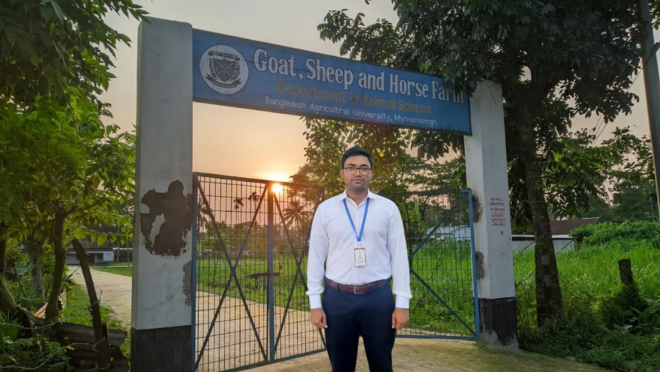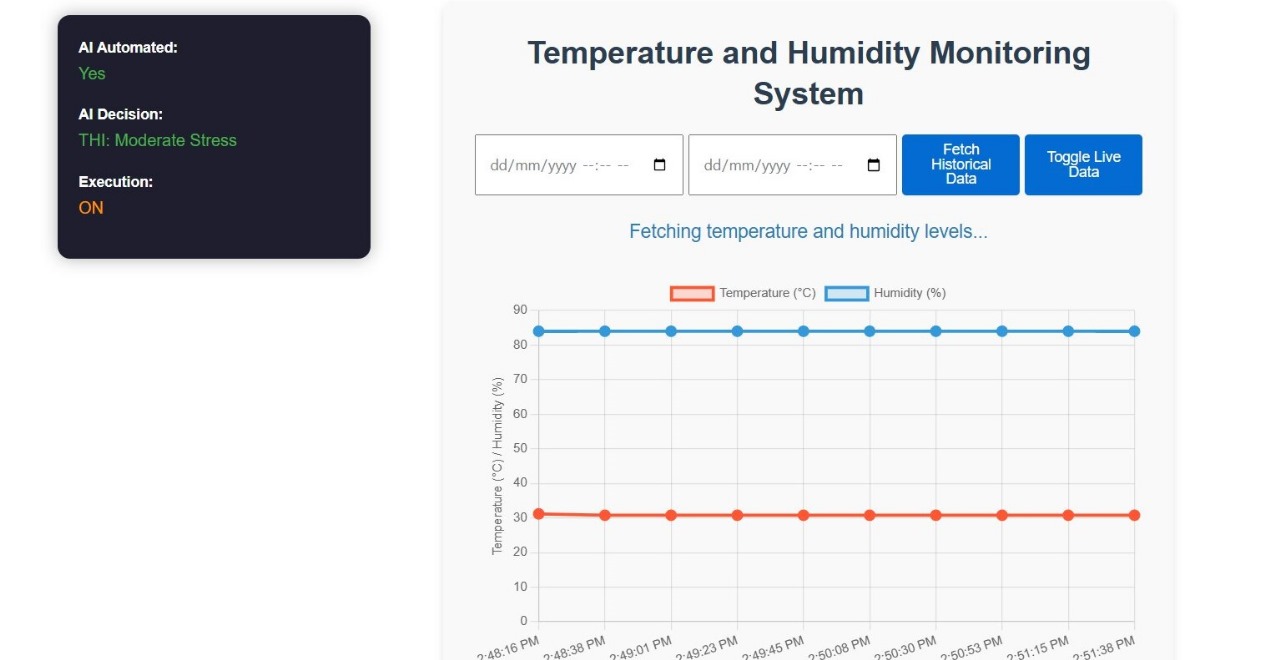BAU student develops low-cost AI system for livestock heat stress management
BAU student develops low-cost AI system for livestock heat stress management

From the dawn of time, agriculture has been the cornerstone of human development. Throughout human history, innovations in cost savings, greater yield, and sturdier crops have paved the way for efficient and productive farming practices for which we are able to sustain such a vast population with a very little amount of arable land.
In keeping with the trend of constant improvement, a student from Bangladesh Agricultural University, Al Momen Pranta, has introduced an AI-powered decision-making model that can be used for effective livestock management. His innovation helps farmers monitor, evaluate, and decide with real-time data what environment is best suited to result in the highest production.

Photo: Courtesy
Motivation
Al Momen Pranta is currently pursuing his master’s in Animal Science at Bangladesh Agricultural University (BAU). In keeping with his academic studies, he discovered the need for such an innovation during his internship. “During my internship period in my own Upazila, I had the opportunity to work closely with local farmers. I observed firsthand the significant impact that high temperature and humidity during the summer have on poultry health and productivity,” says Pranta.
Farmers, for a long while now, have faced many challenges in monitoring real-time conditions of their poultry. This is due to the absence of real-time data, lack of proper knowledge, and even accurate information about the poultry’s condition itself. This is a significant obstacle in ensuring greater yield.
“Many farmers were either unaware of when to activate cooling systems like fans or couldn’t respond quickly enough due to the absence of timely data. Witnessing these practical challenges during my internship inspired me to develop an automated, accurate, and low-cost AI-powered system.”
Globally, this is also a widely recognised problem in the field of livestock production. Climate change has been the issue that is alarming farmers, as with constant change from season to season, the pattern of climate is becoming surprisingly unpredictable. “I chose livestock heat stress as the focus area. Addressing this issue not only improves animal welfare and productivity but also helps farmers adapt to the challenges posed by climate change.”
Beneath the technology
In facing the challenges of temperature monitoring, heat regulation, and real-time data harvest, Pranta’s AI-powered system plays an important part by completing all these tasks in real time at once.
“The system continuously monitors environmental parameters like temperature and humidity through connected sensors. These data are transmitted in real time to a cloud database, where a machine learning model classifies the heat stress level based on international standards. The AI then makes the final decision and sends signals to initiate necessary actions for heat stress management. All decisions are logged, and comprehensive reports are accessible via an easy-to-use web interface,” explains Pranta.
The system also integrates data obtained through various devices and sensors, which makes the system automated as it can evaluate and make decisions in real time, which is challenging even for the aptly experienced farmers. “IoT integration is central to the system’s automation. Sensors collect data at frequent intervals, which are sent through Wi-Fi-enabled microcontrollers to cloud services like ThingSpeak. This setup allows continuous data flow without manual intervention.”
Affordability is also a valuable factor in determining the system’s feasibility. Farmers would obviously steer away from any new process if they feel it costs more than it yields. Therefore, Pranta is able to keep the cost of setup of this innovative AI system to only Tk2500. It also required careful sourcing of materials and creative solutions to complex problems that are not so visible to the naked eye.
Pranta expressed this achievement, “Open-source software and cloud platforms with free usage tiers were utilised to minimise both development and operational expenses. The system’s design focuses on essential functions only, which reduces hardware requirements and wiring complexity, keeping the total setup cost very low.”
The unique trait guaranteed to help its user
The main advantage of such a system is that it is fully automated. No outset input is needed when the system is up and running; therefore, it is hassle-free. “Unlike many existing systems that rely on expensive hardware or manual intervention,” says Pranta.
The system is also acclimated to the weather conditions prevalent in Bangladesh. “Its extremely low cost makes it accessible for small and medium farmers who often cannot afford commercial solutions.
Moreover, the integration of real-time AI classification with IoT-based actuation is tailored specifically for local environmental conditions and resource constraints,” Pranta elaborates.
Large-scale introduction to the farmers has not been done yet. However, the initial response from its test users has been very positive, and the AI has been able to provide real-time data accurately and smoothly.
“During preliminary demonstrations to academic and research audiences, there was strong interest and positive feedback regarding its potential to offer an affordable, automated heat stress management solution.” The system has already been tested at the Goat, Sheep, and Horse Research Farm under the Faculty of Animal Husbandry at BAU.
Challenges
As this was only a student-led project, Pranta had the challenge of funding the whole project all by himself. Every piece of equipment was purchased and sourced by him. However, Pranta did use open-source and free cloud services for minimising expenses.
The time was also very intensive for Pranta. “From the initial idea to the functional prototype and small-scale trials, the entire process took about six months. Machine learning model training with real data, hardware assembly, software development, AI integration, and automation setup were all carried out in parallel, which helped streamline the timeline and accelerate progress.”
Therefore, the results are also fully capable of functioning automatically. “This system proactively monitors and responds in real time, ensuring the animals remain within comfortable environmental ranges. This reduces physiological stress, improves health, and enhances overall welfare.”
Long-term vision
The low cost and efficient setup make the AI system suitable for both domestic and commercial use. There is also long-term utility for the farmers as they get equipped with the technology by getting used to it.
“By mitigating heat stress effectively, farmers can expect improved growth rates, better feed conversion, reduced mortality, and higher production yields. This translates to significant economic gains, especially during peak summer months when losses are usually highest,” expressed Pranta.
Pranta also wants to commercialise the AI system. Bangladesh is a prime location for implementing innovative solutions, as the sector of agriculture still lacks twenty-first-century technology.
“I plan to commercialise the system by partnering with agricultural startups and cooperatives to produce a more affordable system. I also aim to offer installation and maintenance services alongside educational workshops to facilitate adoption,” said Pranta.
Pranta’s work has been an inspiration for young innovators. Having been a student himself, Pranta has shown the possibility of practical implementation of his theoretical understanding of AI and knowledge of animal management.
He hopes that his achievement helps young minds to aspire to do the same. “This project reinforced my belief that modern technology like ML, AI, and IoT can revolutionise traditional farming practices, making them more sustainable, efficient, and humane.”
He finished the interview stating, “I would encourage them to stay curious, leverage open-source tools, and explore the potential of machine learning and AI to solve real-world problems in various fields. Focusing on challenges faced by local communities is essential.


